
2.1 实验动物数量分析 共有26只动物进入实验,实验中无动物意外死亡或其他影响实验结果的情况,所有实验动物最终都进入结果分析。
2.2 Duchenne型肌营养不良症模型鼠的鉴定 研究中用来繁殖Duchenne型肌营养不良症模型鼠的种鼠是杂合子鼠(mdx/utrn+/−),该杂合子鼠是在传统mdx鼠的基础上加以构建的,其方法为在mdx鼠的一个utrophin等位基因的7号外显子上插入Neo-knockout结构。这样形成的杂合子鼠一个utrophin等位基因7号外显子上提前出现终止密码而功能缺陷,另一个功能正常,其基因表型为dystrophin−/−/ utrophin+/−。
将杂合子鼠雌雄配对饲养来繁殖后代。按照孟德尔遗传规律,后代中25%为mdx鼠、50%为杂合子鼠,25%为dko鼠。应用双重PCR系统检测繁殖后代的基因表型,确认其utrophin基因是否正常(图1),并加以筛选。为进一步确认动物模型的准确性,应用免疫荧光染色的方法检测了模型动物肌肉中dystrophin和utrophin的表达。
PCR的结果表明,选用的3个引物和PCR系统能很好的扩增出正常或是截短utrophin基因7号外显子。正常7号外显子扩增片断长为340 bp,Neo-knockout结构插入后扩增出的长度为285 bp。若只是扩增出340 bp的片断,表明该小鼠的两条utrophin基因均正常,为mdx鼠;若仅仅扩增出285 bp的片断,表明该小鼠的两条utrophin基因均被截短了,为dko鼠;若同时扩增出两条片断,则意味着一个utrophin等位基因正常,另一个被截短,为杂合子小鼠(见图1)。

免疫荧光染色的结果和作者预期相符合,作为对照组的正常C57小鼠肌肉组织dystrophin和utrophin表达均为阳性;mdx鼠肌肉中dystrophin表达阴性,但是utrophin表达上调,荧光反应强于正常C57小鼠,与之前的文献报道结果符合;dko鼠肌肉中dystrophin和utrophin均为阴性表达(见图2)。总之,这些结果表明作者引进并饲养繁殖的动物模型是成功的,在基因型和蛋白表达层面均符合实验的要求,可以用于进一步的研究。
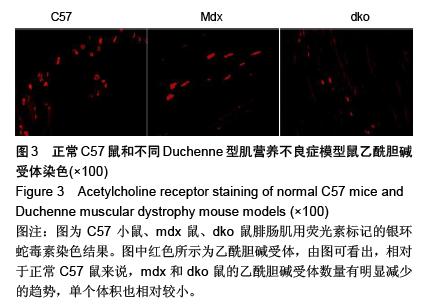
2.3 Duchenne型肌营养不良症模型鼠神经肌肉接头结构受损结果 腓肠肌纵切面厚片荧光染色结果显示,正常C57小鼠的神经肌肉接头突触后膜上乙酰胆碱受体聚集良好,每个肌纤维一般只有一两个受体聚集的部位。此外,乙酰胆碱受体在整块肌肉中成簇状聚集分布。而mdx鼠和dko鼠肌肉终板膜上的乙酰胆碱受体的形态与正常鼠比较有明显的差异,其数量较少,单个受体体积也减小(见图3)。
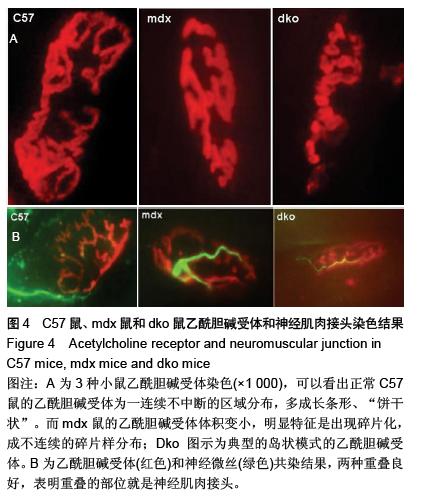
经放大后观察,正常C57鼠的乙酰胆碱受体表现为一连续不中断的“饼干状”区域,多成长条状,少数为圆形。而mdx鼠的乙酰胆碱受体体积变小,其突出特征是呈现碎片化,成不连续的碎片样分布。Dko鼠受体变化与mdx鼠类似,但是一种乙酰胆碱受体的特殊模式-岛状模式(表现为由多个具有较暗中心的明亮区域构成)-在dko鼠中更为多见(见图4)。为进一步量化乙酰胆碱受体受损程度,对受体碎片化进行分类。如果乙酰胆碱受体结构分为3个或是3个以下的区域构成,作者将其定义为“连续的受体”;相反,如果分裂成3个以上的区域,则定义为“不连续的受体”,后者比率的增加意味着神经肌肉接头的结构受到损伤。
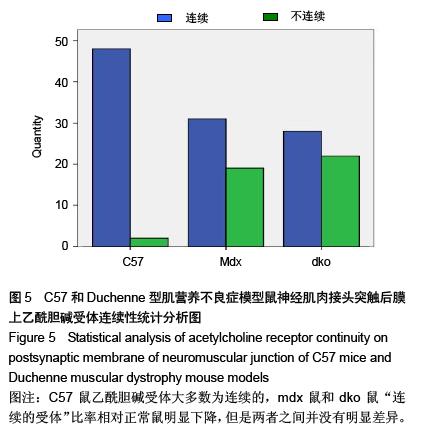
统计结果表明,正常C57小鼠大多数的受体都是“连续的”,而mdx鼠“不连续”的受体比率明显增加。Dko鼠“不连续”的受体比率与正常小鼠相比也明显增加,但是与mdx鼠则没有显着的差异。但是,dko鼠肌肉中岛状模式的乙酰胆碱受体明显多于mdx鼠(见
表1,
图5)。
.jpg)
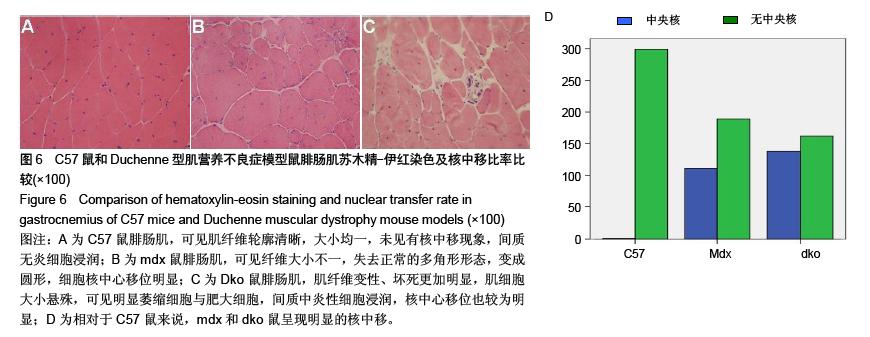
2.4 Duchenne型肌营养不良症模型鼠肌肉组织病理改变 采用12周龄的小鼠腓肠肌冰冻切片进行苏木精-伊红染色,用于观察Duchenne型肌营养不良症模型鼠肌肉病理形态的变化。结果可见,C57小鼠肌肉组织镜下肌纤维呈典型的多角形,大小较为均一,细胞轮廓清晰、完整,肌细胞核位于细胞周边,未见有细胞核中移现象,肌纤维间隙正常,肌内束、肌间束结构完整,肌纤维间质中无炎细胞浸润。
Mdx鼠腓肠肌肌细胞横截面积大小不一、有萎缩和肥大细胞,肌纤维失去正常的多角形形态,变成圆形,脂肪和纤维组织浸润不明显,而肌细胞核中心移位明显,间质中有炎细胞浸润。Dko鼠表现出更明显肌纤维变性、坏死,肌纤维大小悬殊,可见明显萎缩细胞与肥大细胞,间质中炎性细胞浸润,可见肌纤维脂肪化和纤维样变性,核中心移位也较为明显(见图6)。
正常情况下,肌细胞核大多位于细胞的边缘,靠近细胞膜分布。当肌纤维受损,细胞处于修复再生状态时,细胞核会向肌细胞中心移动,称之为细胞核中移。镜下计数含有中心移位细胞核的肌纤维和正常肌纤维,可计算出核中心移位肌纤维比例,一定程度上可以反映肌纤维再生的程度。统计结果显示,相对与C57鼠来说,mdx鼠和dko鼠呈现明显的核中移,但是两者之间的核中移比例并无明显差别(见图6)。
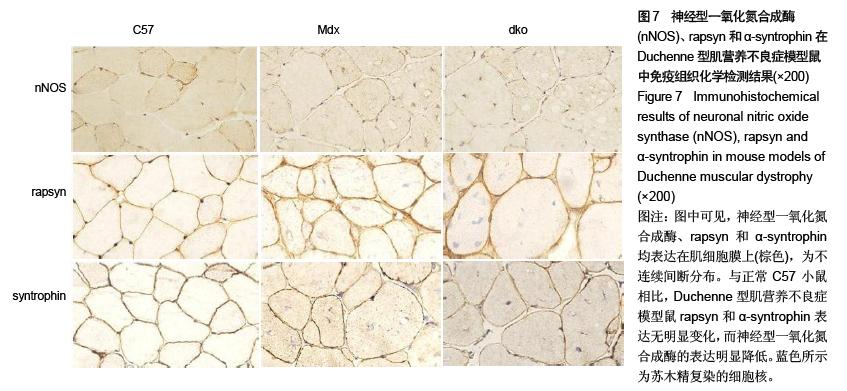
2.5 Dystrophin相关蛋白复合体成分在Duchenne型肌营养不良症模型鼠中表达的变化 Dystrophin相关蛋白复合体中有多个成分参与到神经肌肉接头结构的维持和稳定,其中神经型一氧化氮合成酶、rapsyn和α-syntrophin尤为重要,其中任何一个成分表达障碍均会影响到正常神经肌肉接头的结构。应用免疫组织化学方法检测了上述3个蛋白在Duchenne型肌营养不良症模型鼠中的表达变化,探讨它们在dystrophin缺陷的基础上,是否参与到乙酰胆碱受体碎片化过程中。
结果显示,在神经肌肉接头发育和形成中发挥重要作用的rapsyn在mdx鼠和dko鼠中的表达均无明显变化,和正常C57鼠表达水平相似。Dystrophin相关蛋白复合体在细胞内重要组成部分α-syntrophin也观察到相似的结果。而神经型一氧化氮合成酶在Duchenne型肌营养不良症模型鼠中的表达明显减低,在mdx鼠和dko鼠肌肉组织中观察到的结果类似(见图7)。这些结果表明,rapsyn和α-syntrophin并不是造成Duchenne型肌营养不良症模型鼠神经肌肉接头结构变化的原因,而神经型一氧化氮合成酶则可能参与到乙酰胆碱受体碎片化的过程。
.jpg)





.jpg)

